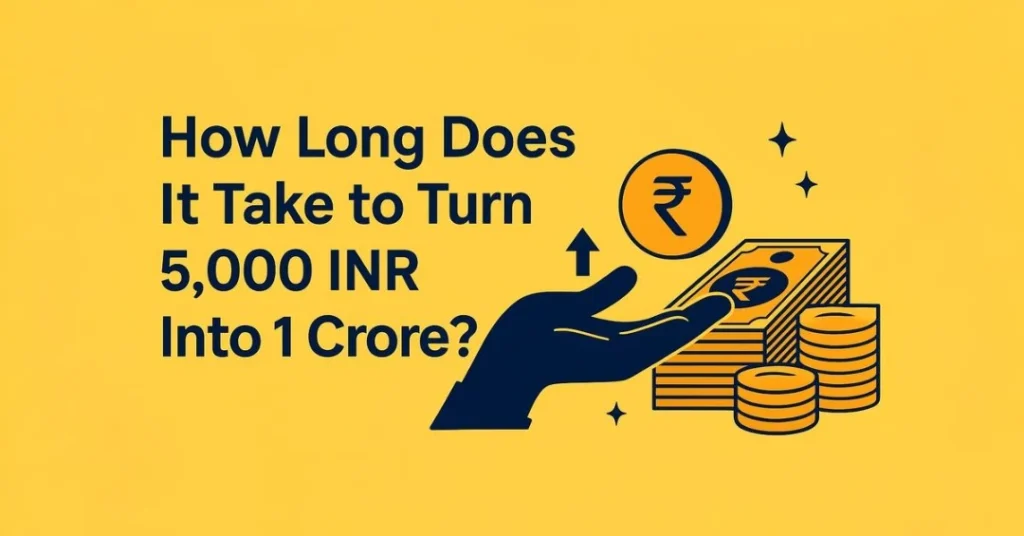Have you ever wondered how long it would take to turn a simple ₹5,000 monthly investment into ₹1 crore? Whether you’re a young professional planning your future or someone looking to build wealth steadily, this blog breaks down the time it takes across various investment options—like SIPs, FDs, PPF, Gold, and more—using the latest interest rates and after-tax returns. This is not financial advice but a detailed guide to help you understand how different investments compound over time.
Investment Comparison Table
| Investment Option | Expected Return (Post-Tax) | Estimated Time to ₹1 Crore |
|---|---|---|
| Savings Account | 2.5% | 50+ years |
| Fixed Deposit (FD) | 5.5% | ~30 years |
| Recurring Deposit (RD) | 5.5% | ~32 years |
| Public Provident Fund (PPF) | 7.1% (Tax-Free) | ~26.5 years |
| Employee Provident Fund (EPF) | 8.15% (Tax-Free) | ~23 years |
| National Pension System (NPS) | 8% | ~24 years |
| Gold (SGB/Digital) | 7% | ~27 years |
| REITs (Real Estate) | 7%–8% | ~24–26 years |
| Systematic Investment Plan (SIP) | 12% | ~20 years |
| Hybrid Mutual Funds | 10% | ~22 years |
| ULIPs | 7%–10% | ~23–28 years |
1. Savings Account
A savings account is the most liquid but least rewarding form of investment. Typically offering around 2%–3% annual interest, the returns do not even beat inflation. The interest earned is fully taxable. While it’s essential for emergency funds and day-to-day expenses, relying solely on a savings account for wealth creation is impractical.
Time to ₹1 Crore: 50+ years
2. Fixed Deposit (FD)
FDs offer fixed returns and are considered one of the safest investment avenues. Most banks offer 6%–7% annual interest before tax. However, the interest earned is fully taxable, bringing the effective return down to ~5.5% for most investors. FDs are suitable for conservative investors seeking capital preservation.
Time to ₹1 Crore: ~30 years
3. Recurring Deposit (RD)
RDs are similar to FDs but allow monthly contributions, making them more accessible for regular savers. Returns are the same as FDs and are also taxed as per income slabs. RDs are suitable for medium-term goals like buying a vehicle or funding a vacation.
Time to ₹1 Crore: ~32 years
4. Public Provident Fund (PPF)
PPF is a government-backed long-term savings scheme offering 7.1% tax-free returns. It has a lock-in period of 15 years and is ideal for risk-averse investors seeking a safe retirement corpus. Returns are compounded annually and exempt from tax under Section 80C.
Time to ₹1 Crore: ~26.5 years
5. Employee Provident Fund (EPF)
EPF is applicable to salaried employees and offers 8.15% annual tax-free returns. Both employer and employee contribute to the fund, with compounding working in favor of long-term wealth building. Withdrawals after retirement are tax-free under certain conditions.
Time to ₹1 Crore: ~23 years
6. National Pension System (NPS)
NPS is a retirement-focused investment with a mix of equity and debt options. It typically offers 8% post-tax returns. Contributions are eligible for tax deductions under Section 80CCD(1B), and a portion of the corpus is tax-free at maturity. Partial annuitization is required.
Time to ₹1 Crore: ~24 years
7. Gold (Digital/SGB)
Investing in gold—especially through Sovereign Gold Bonds (SGBs) or digital gold—has historically yielded 6%–8% annual returns. It’s an excellent hedge against inflation and economic uncertainty. SGBs offer an added 2.5% annual interest and capital gains are tax-free if held to maturity.
Time to ₹1 Crore: ~27 years
8. Real Estate Investment Trusts (REITs)
REITs offer the benefit of real estate exposure without owning physical property. They typically yield 7%–8% annually. Income is partly taxable, and returns depend on market cycles and occupancy rates. Suitable for medium-risk investors seeking diversification.
Time to ₹1 Crore: ~24–26 years
9. Systematic Investment Plan (SIP – Equity Mutual Funds)
SIPs are one of the most efficient ways to grow wealth. By investing in equity mutual funds through SIPs, investors can expect 12%–15% returns annually. SIPs harness the power of rupee cost averaging and compounding over time. Ideal for long-term financial goals.
Time to ₹1 Crore: ~20 years
10. Hybrid Mutual Funds
These funds invest in a mix of equity and debt instruments. They offer a balanced approach, delivering around 10% returns with moderate volatility. Hybrid funds are perfect for investors transitioning from low-risk to moderate-risk assets.
Time to ₹1 Crore: ~22 years
11. ULIPs (Unit Linked Insurance Plans)
ULIPs combine life insurance and market-linked investments. While they offer decent returns (7%–10%) over a long term, charges like premium allocation and fund management fees can eat into profits. Ideal only for those seeking insurance along with investment.
Time to ₹1 Crore: ~23–28 years
Visual Comparis

Use Calculator to calculate how long it takes
How Long to Reach ₹1 Crore with Monthly Investment?
Best Option?
The best choice depends on your risk appetite:
- Low risk, stable: PPF, EPF, RD, Gold
- High growth: SIPs, Hybrid Funds
- Balanced: NPS, ULIPs, REITs
Mixing 2-3 options may provide stability and growth.
Helpful Calculators
- SIP Calculator
- PPF Calculator
- FD Calculator
- Gold SIP Calculator
- NPS Calculator
- Mutual Fund Calculator
- Lumpsum Calculator
Final Thoughts
No matter where you start, ₹5,000 a month can grow into ₹1 crore with time, patience, and compounding. Use calculators, track goals, and always diversify. This post gives a data-backed roadmap—not investment advice—so you can make informed, self-guided decisions for your financial future.






